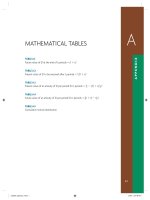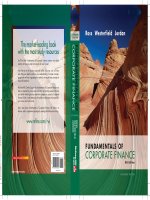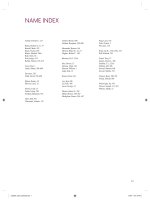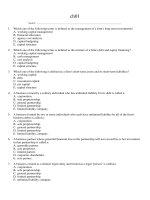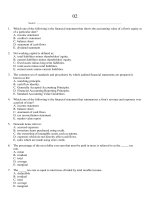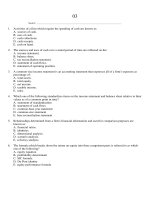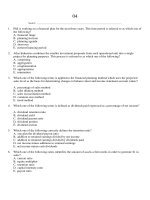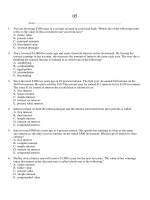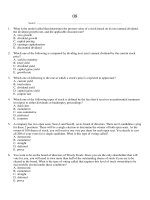Appendix b key equations fundamentals of corporate finance; standard edition (8th edition)
Bạn đang xem bản rút gọn của tài liệu. Xem và tải ngay bản đầy đủ của tài liệu tại đây (151.69 KB, 5 trang )
CHAPTER 2
5.
1. The balance sheet identity or equation:
Assets ϭ Liabilities
[2.1]
ϩ Shareholders’ equity
6.
2. The income statement equation:
Revenues Ϫ Expenses ϭ Income
[2.2]
3. The cash flow identity:
Cash flow from assets ϭ
Cash flow to creditors ϩ
[2.3] 7.
Cash flow to stockholders
where
a. Cash flow from assets ϭ Operating cash
8.
flow (OCF) Ϫ Net capital spending Ϫ
Change in net working capital (NWC)
(1) Operating cash flow ϭ Earnings
9.
before interest and taxes (EBIT) ϩ
Depreciation Ϫ Taxes
(2) Net capital spending ϭ Ending net
fixed assets Ϫ Beginning net fixed
assets ϩ Depreciation
10.
(3) Change in net working capital ϭ
Ending NWC Ϫ Beginning NWC
b. Cash flow to creditors ϭ Interest paid Ϫ
Net new borrowing
c. Cash flow to stockholders ϭ Dividends
paid Ϫ Net new equity raised
CHAPTER 3
11.
12.
1. The current ratio:
Current assets
Current ratio ϭ _______________
[3.1]
Current liabilities
2. The quick or acid-test ratio:
13.
Current assets Ϫ Inventory
______________________
Quick ratio ϭ
[3.2]
Current liabilities
3. The cash ratio:
Cash
[3.3] 14.
Cash ratio ϭ _______________
Current liabilities
4. The ratio of net working capital to total assets:
Net working capital to total assets
Net working capital
ϭ _________________
[3.4]
Total assets
The interval measure:
Interval measure
Current assets
ϭ ________________________
Average daily operating costs
The total debt ratio:
Total debt ratio
Total assets Ϫ Total equity
ϭ ______________________
Total assets
The debt-equity ratio:
Debt-equity ratio
ϭ Total debt͞Total equity
The equity multiplier:
Equity multiplier
ϭ Total assets͞Total equity
The long-term debt ratio:
Long-term debt ratio
Long-term debt
ϭ _________________________
Long-term debt ϩ Total equity
The times interest earned (TIE) ratio:
EBIT
Times interest earned ratio ϭ _______
Interest
The cash coverage ratio:
Cash coverage ratio
EBIT ϩ Depreciation
ϭ __________________
Interest
The inventory turnover ratio:
Inventory turnover
Cost of goods sold
ϭ ________________
Inventory
The average days’ sales in inventory:
Days’ sales in inventory
365 days
ϭ ________________
Inventory turnover
The receivables turnover ratio:
Receivables turnover
Sales
ϭ _________________
Accounts receivable
APPENDIX
B
KEY EQUATIONS
[3.5]
[3.6]
[3.7]
[3.8]
[3.9]
[3.10]
[3.11]
[3.12]
[3.13]
[3.14]
B-1
ros3062x_App_B_Standard.indd 1
2/9/07 3:53:12 PM
B-2
APPENDIX B
Key Equations
15. The days’ sales in receivables:
Days’ sales in receivables
365 days
ϭ __________________
Receivables turnover
16. The net working capital (NWC) turnover ratio:
Sales
NWC turnover ϭ _____
NWC
17. The fixed asset turnover ratio:
Sales
Fixed asset turnover ϭ _____________
Net fixed assets
18. The total asset turnover ratio:
Sales
Total asset turnover ϭ __________
Total assets
19. Profit margin:
Net income
Profit margin ϭ __________
Sales
20. Return on assets (ROA):
Net income
Return on assets ϭ __________
Total assets
21. Return on equity (ROE):
Net income
Return on equity ϭ __________
Total equity
22. The price-earnings (PE) ratio:
Price per share
PE ratio ϭ ________________
Earnings per share
23. The market-to-book ratio:
Market-to-book ratio
Market value per share
ϭ ___________________
Book value per share
24. The Du Pont identity:
Sales ϫ ______
Net income ϫ ______
Assets
ROE ϭ __________
Assets
Sales
Equity
4. The capital intensity ratio:
[3.15]
[3.16]
[3.17]
[3.18]
[3.19]
[3.20]
[3.21]
[3.22]
[3.23]
[3.24]
¥
¦
Return on assets
ROE ϭ Profit margin
ϫ Total asset turnover
ϫ Equity multiplier
CHAPTER 4
1. The dividend payout ratio:
Dividend payout ratio
ϭ Cash dividends͞Net income
2. The internal growth rate:
ROA ϫ b
Internal growth rate ϭ ____________
1 Ϫ ROA ϫ b
3. The sustainable growth rate:
ROE ϫ b
Sustainable growth rate ϭ ____________
1 Ϫ ROE ϫ b
ros3062x_App_B_Standard.indd 2
Total assets
Capital intensity ratio ϭ __________
Sales
1
ϭ ________________
Total asset turnover
CHAPTER 5
1. The future value of $1 invested for t periods at rate
of r per period:
Future value ϭ $1 ϫ (1 ϩ r)t
2. The present value of $1 to be received t periods in
the future at a discount rate of r:
PV ϭ $1 ϫ [1͞(1 ϩ r)t] ϭ $1͞(1 ϩ r)t
3. The relationship between future value and present
value (the basic present value equation):
PV ϫ (1 ϩ r)t ϭ FVt
PV ϭ FVt ͞(1 ϩ r)t ϭ FVt ϫ [1͞(1 ϩ r)t]
[5.1]
[5.2]
[5.3]
CHAPTER 6
1. The present value of an annuity of C dollars per period
for t periods when the rate of return or interest rate is r:
Annuity present value
1 Ϫ Present value factor
ϭ C ϫ ____________________
r
1
Ϫ
[1͞(1
ϩ
r)t]
[6.1]
ϭ C ϫ ______________
r
(
{
)
}
2. The future value factor for an annuity:
Annuity FV factor
ϭ (Future value factor Ϫ 1)͞r
ϭ [(1 ϩ r)t Ϫ 1]͞r
3. Annuity due value ϭ Ordinary annuity value
ϫ (1 ϩ r)
[6.2]
[6.3]
4. Present value for a perpetuity:
PV for a perpetuity ϭ C͞r ϭ C ϫ (1͞r)
[6.4]
5. Effective annual rate (EAR), where m is the number
of times the interest is compounded during the year:
EAR ϭ [1 ϩ (Quoted rate͞m)]m Ϫ 1
[6.5]
6. Effective annual rate (EAR), where q stands for the
continuously compounded quoted rate:
EAR ϭ e q Ϫ 1
[6.6]
CHAPTER 7
[4.1]
[4.2]
[4.3]
1. Bond value if bond has (1) a face value of F paid at
maturity, (2) a coupon of C paid per period, (3) t periods to
maturity, and (4) a yield of r per period:
Bond value
ϭ C ϫ [1 Ϫ 1͞(1 ϩ r)t]͞r ϩ F͞(1 ϩ r)t
[7.1]
Bond value
Present value
Present value
ϭ
ϩ
of the coupons
of the face amount
2/9/07 3:53:13 PM
APPENDIX B
2. The Fisher effect:
1 ϩ R ϭ (1 ϩ r) ϫ (1 ϩ h)
Rϭrϩhϩrϫh
RϷrϩh
[7.2]
[7.3]
[7.4]
CHAPTER 8
1. The dividend growth model:
D0 ϫ (1 ϩ g) ______
D1
P0 ϭ ___________
ϭ
RϪg
RϪg
2. Required return:
R ϭ D1͞P0 ϩ g
[8.3]
[8.5]
1. Net present value (NPV):
NPV ϭ Present value of future cash flows Ϫ Investment
cost
2. Payback period:
Payback period ϭ Number of years that pass before the
sum of an investment’s cash flows equals the cost of the
investment
3. Discounted payback period:
Discounted payback period ϭ Number of years that pass
before the sum of an investment’s discounted cash flows
equals the cost of the investment
4. The average accounting return (AAR):
Average net income
AAR ϭ _________________
Average book value
5. Internal rate of return (IRR):
IRR ϭ Discount rate of required return such that
the net present value of an investment is zero
6. Profitability index:
PV of cash flows
Profitability index ϭ ________________
Cost of investment
CHAPTER 10
1. Bottom-up approach to operating cash flow (OCF):
OCF ϭ Net income ϩ Depreciation
[10.1]
2. Top-down approach to operating cash flow (OCF):
OCF ϭ Sales Ϫ Costs Ϫ Taxes
[10.2]
3. Tax shield approach to operating cash flow (OCF):
OCF ϭ (Sales Ϫ Costs) ϫ (1 Ϫ T)
ϩ Depreciation ϫ T
[10.3]
CHAPTER 11
ros3062x_App_B_Standard.indd 3
3. Cash break-even level:
Q ϭ FC͞(P Ϫ v)
4. Financial break-even level:
Q ϭ (FC ϩ OCF*)͞(P Ϫ v)
where
OCF* ϭ Zero NPV cash flow
5. Degree of operating leverage (DOL):
DOL ϭ 1 ϩ FC͞OCF
B-3
[11.4]
CHAPTER 12
1. Variance of returns, Var(R) or 2:
CHAPTER 9
1. Accounting break-even level:
Q ϭ (FC ϩ D)͞(P Ϫ v)
2. Relationship between operating cash flow (OCF)
and sales volume:
Q ϭ (FC ϩ OCF)͞(P Ϫ v)
Key Equations
[11.1]
1 [(R Ϫ R¯ )2 ϩ · · ·
Var(R) ϭ _____
TϪ1 1
ϩ (RT Ϫ R¯ )2]
2. Standard deviation of returns, SD(R) or :
[12.3]
______
SD(R) ϭ ͙ Var(R)
CHAPTER 13
1. Risk premium:
Risk premium ϭ Expected return
– Risk-free rate
2. Expected return on a portfolio:
E(RP) ϭ x1 ϫ E(R1) ϩ x 2 ϫ E(R2) ϩ · · ·
ϩ xn ϫ E(R n)
3. The reward-to-risk ratio:
E[Ri] Ϫ Rf
Reward-to-risk ratio ϭ _________
βi
4. The capital asset pricing model (CAPM):
E(Ri ) ϭ Rf ϩ [E(RM) Ϫ Rf ] ϫ βi
[13.1]
[13.2]
[13.7]
CHAPTER 14
1. Value of a call option at maturity:
a. C1 ϭ 0 if (S1 Ϫ E) Յ 0
b. C1 ϭ S1 Ϫ E if (S1 Ϫ E) Ͼ 0
2. Bounds on the value of a call option:
a. Upper bound:
C0 Յ S0
b. Lower bound:
C0 Ն 0 if S0 Ϫ E Ͻ 0
C0 Ն S0 Ϫ E if S0 Ϫ E Ն 0
3. S0 ϭ C0 ϩ E͞(1 ϩ R f )
C0 ϭ S0 Ϫ E͞(1 ϩ R f )
[14.1]
[14.2]
[14.3]
[14.4]
[14.5]
[11.3]
2/9/07 3:53:14 PM
B-4
APPENDIX B
Key Equations
4. Value of a call that is certain to finish in-the-money:
Call option value
ϭ Stock value
Ϫ Present value of the exercise price
C0 ϭ S0 Ϫ E͞(1 ϩ Rf )t
[14.6]
CHAPTER 15
1. Required return on equity, RE (dividend growth model):
RE ϭ D1͞P0 ϩ g
[15.1]
2. Required return on equity, RE (CAPM):
RE ϭ R f ϩ βE ϫ (RM Ϫ R f )
[15.2]
3. Required return on preferred stock, RP:
RP ϭ D͞P0
[15.3]
4. The weighted average cost of capital (WACC):
WACC ϭ (E͞V) ϫ RE ϩ (D͞V) ϫ RD
ϫ (1 Ϫ TC)
[15.6]
5. Weighted average flotation cost, fA:
E ϫ f ϩ __
Dϫf
fA ϭ __
[15.8]
E
D
V
V
CHAPTER 16
1. Rights offerings:
a. Number of new shares:
Number of new shares
Funds to be raised
ϭ _______________
[16.1]
Subscription price
b. Number of rights needed:
Number of rights needed to buy a share of stock
Old shares
ϭ __________
[16.2]
New shares
c. Value of a right:
Value of a right ϭ Rights-on price Ϫ Ex-rights
price
CHAPTER 19
1. The operating cycle:
Operating cycle ϭ Inventory period
ϩ Accounts receivable period
2. The cash cycle:
Cash cycle ϭ Operating cycle
Ϫ Accounts payable period
1. Float measurement:
a. Average daily float:
Total float
Average daily float ϭ _________
Total days
b. Average daily float:
Average daily float
ϭ Average daily receipts
ϫ Weighted average delay
2. The Baumol-Allais-Tobin (BAT) model:
a. Opportunity costs:
Opportunity costs ϭ (C͞2) ϫ R
b. Trading costs:
Trading costs ϭ (T͞C) ϫ F
c. Total cost:
Total cost ϭ Opportunity costs
ϩ Trading costs
d. The optimal initial cash balance:
C* ϭ ͙ළළළළළළළළළළ
(2T ϫ F)͞R
3. The Miller-Orr model:
a. The optimal cash balance:
C* ϭ L ϩ (3͞4 ϫ F ϫ σ2͞R)1͞3
b. The upper limit:
U* ϭ 3 ϫ C* Ϫ 2 ϫ L
CHAPTER 21
1. Modigliani-Miller Propositions (no taxes):
1. The size of receivables:
Accounts receivable
ϭ Average daily sales ϫ ACP
2. NPV of switching credit terms:
a. Present value of switching:
PV ϭ [(P Ϫ v)(QЈ Ϫ Q)]͞R
b. Cost of switching:
Cost of switching ϭ PQ ϩ v(QЈ Ϫ Q)
c. NPV of switching:
NPV of switching ϭ Ϫ[PQ ϩ v(QЈ Ϫ Q)]
ϩ (P Ϫ v)
ϫ (QЈ Ϫ Q)͞R
ros3062x_App_B_Standard.indd 4
[17.1]
[17.2]
[17.3]
[19.5]
CHAPTER 20
CHAPTER 17
a. Proposition I:
VL ϭ VU
b. Proposition II:
RE ϭ RA ϩ (RA Ϫ RD) ϫ (D͞E )
2. Modigliani-Miller propositions (with taxes):
a. Value of the interest tax shield:
Value of the interest tax shield
ϭ (TC ϫ RD ϫ D)͞RD
ϭ TC ϫ D
b. Proposition I:
VL ϭ VU ϩ TC ϫ D
c. Proposition II:
RE ϭ RU ϩ (RU Ϫ RD) ϫ (D͞E )
ϫ (1 Ϫ TC)
[19.4]
[20.1]
[20.2]
[20A.1]
[20A.2]
[20A.3]
[20A.4]
[20A.5]
[20A.6]
[21.1]
[21.4]
[21.5]
[21.6]
[17.4]
2/9/07 3:53:15 PM
APPENDIX B
3. NPV of granting credit:
a. With no repeat business:
NPV ϭ Ϫv ϩ (1 Ϫ )P͞(1 ϩ R)
b. With repeat business:
NPV ϭ Ϫv ϩ (1 Ϫ )(P Ϫ v)͞R
4. The economic order quantity (EOQ) model:
a. Total carrying costs:
Total carrying costs
ϭ Average inventory
ϫ Carrying costs per unit
ϭ (Q͞2) ϫ CC
b. Total restocking costs:
Total restocking costs
ϭ Fixed cost per order
ϫ Number of orders ϭ F ϫ (T͞Q)
c. Total costs:
Total costs ϭ Carrying costs
ϩ Restocking costs
ϭ (Q͞2) ϫ CC
ϩ F ϫ (T͞Q)
d. The optimal order size Q*:
Q* ϭ
ros3062x_App_B_Standard.indd 5
ළළළළළළළ
2T ϫ F
CC
͙_______
Key Equations
B-5
CHAPTER 22
[21.8]
[21.9]
[21.10]
1. Purchasing power parity (PPP):
E(St) ϭ S0 ϫ [1 ϩ (hFC Ϫ hUS)]t
2. Interest rate parity (IRP):
a. Exact, single period:
F1͞S0 ϭ (1 ϩ RFC)͞(1 ϩ RUS)
b. Approximate, multiperiod:
Ft ϭ S0 ϫ [1 ϩ (RFC Ϫ RUS)]t
3. Uncovered interest parity (UIP):
E(St) ϭ S0 ϫ [1 ϩ (RFC Ϫ RUS)]t
4. International Fisher effect (IFE):
RUS Ϫ hUS ϭ RFC Ϫ hFC
[22.3]
[22.4]
[22.7]
[22.9]
[22.10]
[21.11]
[21.12]
[21.16]
2/9/07 3:53:16 PM
